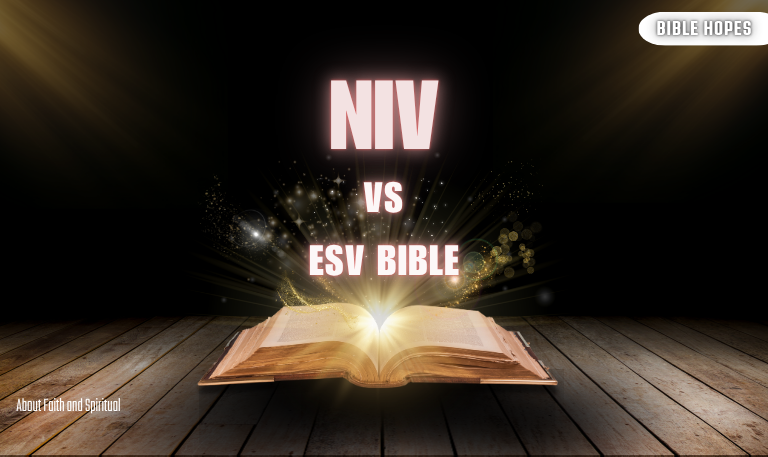When it comes to choosing a Bible translation, two of the most widely used versions today are the New International Version (NIV) and the English Standard Version (ESV). Both have millions of readers worldwide, beloved for their unique qualities and faithful rendering of Scripture. But which one is right for you? Understanding their differences, strengths, and ideal use cases can help you pick the perfect Bible for study, devotion, or teaching.
In this comprehensive guide, we’ll explore everything you need to know about the NIV vs ESV Bible debate — from their translation philosophies and textual sources to readability, theological nuances, and practical usage.
What Are the NIV and ESV Bibles?
NIV (New International Version):
Launched in the 1970s, the NIV Bible was created to offer a contemporary, easily readable Bible translation that remains faithful to the original texts. It is designed for clarity and accessibility, aiming to balance accuracy with a thought-for-thought (dynamic equivalence) approach.
ESV (English Standard Version):
Released in 2001, the ESV seeks to provide an “essentially literal” translation that is faithful to the wording and structure of the original languages. It leans toward a word-for-word (formal equivalence) philosophy, emphasizing precision and literary quality while maintaining readability.
Read Also: Atheism Vs Agnosticism
History and Origins of NIV and ESV
NIV Bible:
The NIV was developed by a multinational team of over 100 scholars from various evangelical denominations. Its first complete edition appeared in 1978, with major revisions in 1984 and a significant update in 2011 to modernize language and reflect updated scholarship.ESV Bible:
The ESV was created by Crossway Books as an update and modernization of the Revised Standard Version (RSV). Its translation team consisted of conservative evangelical scholars focused on maintaining a literal translation that balances readability and formal accuracy.
Translation Philosophy: Dynamic Equivalence vs Formal Equivalence
| Translation Type | Description | NIV | ESV |
|---|---|---|---|
| Dynamic Equivalence | Focuses on thought-for-thought translation, emphasizing meaning and readability | Primary philosophy | Secondary (used minimally) |
| Formal Equivalence | Focuses on word-for-word accuracy and maintaining original text structure | Used selectively | Primary philosophy |
NIV prioritizes the thought-for-thought approach to ensure clarity and natural English flow, making it accessible to a broad audience, including non-native English speakers.
ESV emphasizes a more literal translation to preserve original sentence structures and theological terms, making it suitable for in-depth study and theological precision.
Textual Sources and Manuscript Bases
NIV uses the latest critical editions of the Masoretic Text for the Old Testament and the Nestle-Aland Greek New Testament for the New Testament, incorporating findings from the Dead Sea Scrolls and other ancient manuscripts.
ESV also relies on the Masoretic Text and Nestle-Aland 27th edition, with a strong focus on maintaining the textual tradition found in the Revised Standard Version (RSV).
Both translations use a similar, well-vetted manuscript base, though the NIV’s committee is more open to occasional textual decisions for better readability.
Language, Style, and Readability
NIV:
Language is contemporary and conversational.
Average reading level is about 7th-8th grade, making it accessible to most readers.
Commonly used for devotional reading, outreach, and church services where clarity is key.
ESV:
More formal and literary style, closer to traditional English Bible translations.
Reading level approximates 10th grade or higher, reflecting more complex sentence structures and vocabulary.
Preferred for serious study, preaching, and memorization.
Accuracy and Faithfulness to Original Texts
| Aspect | NIV | ESV |
|---|---|---|
| Literalness | Balances literal meaning with clarity | Highly literal and precise |
| Theological neutrality | Attempts neutral wording to avoid bias | Focuses on literal accuracy even if archaic |
| Textual variants | Uses dynamic choice to clarify meaning | Prefers literal representation of variants |
Examples of differences:
John 3:16
NIV: “For God so loved the world that he gave his one and only Son…”
ESV: “For God so loved the world, that he gave his only Son…”
Some verses may differ slightly in phrasing but convey the same core meaning.
Theological and Doctrinal Considerations
Both translations are produced by evangelical scholars and share core Christian doctrines. However:
NIV sometimes opts for gender-neutral language where context allows (e.g., “brothers and sisters” vs. “brothers”).
ESV tends to retain traditional gendered language, appealing to readers who prefer formal equivalence and traditional phrasing.
Neither translation is doctrinally biased, but nuances in wording can influence interpretation in some passages.
Popularity and Usage Across Denominations
NIV:
One of the most popular Bibles globally, widely used in evangelical, Baptist, Methodist, and Pentecostal churches.
Often the default Bible for Bible apps, youth groups, and Sunday schools.
ESV:
Gaining popularity in Reformed, Presbyterian, Anglican, and conservative evangelical circles.
Recommended by many seminaries and pastors for deep theological study.
Pros and Cons of the NIV Bible
Pros
Easy to read and understand
Suitable for new believers and general audiences
Broad denominational acceptance
Updated regularly with current English usage
Cons
Less literal than some prefer
Some theological nuances lost in dynamic translation
Gender-neutral language debated by some conservatives
Pros and Cons of the ESV Bible
Pros
Highly accurate and literal
Preserves traditional wording and theological terms
Excellent for deep study and memorization
Beautiful literary style
Cons
Can be difficult for new or casual readers
More formal language may feel less approachable
Less updated language, some archaic phrases remain
Choosing the Right Bible for You
Consider these factors when choosing between NIV and ESV:
| Factor | NIV | ESV |
|---|---|---|
| Reading ease | Excellent for all levels | Better for advanced readers |
| Personal devotional use | Highly recommended | Good but may require study aids |
| Academic/Theological study | Good but less literal | Preferred for accuracy |
| Church setting | Very popular and accessible | Popular in traditional services |
| Memorization | Easier due to simpler language | More challenging but precise |
Popular NIV and ESV Study Bibles and Resources
NIV Study Bibles:
NIV Study Bible (Zondervan)
Life Application Study Bible (NIV)
ESV Study Bibles:
ESV Study Bible (Crossway)
Reformation Study Bible (ESV)
Digital Apps:
YouVersion (offers both NIV and ESV)
Olive Tree Bible App
Logos Bible Software
Read Also: Who Was Barak in the Bible
NIV vs ESV Bible FAQs
Q: Which Bible version is more accurate: NIV or ESV?
A: The ESV is generally more literal, adhering closely to the original language, while the NIV balances accuracy with readability.
Q: Is NIV easier to understand than ESV?
A: Yes, the NIV uses simpler, contemporary language designed for a broader audience.
Q: Which Bible version is better for memorization?
A: The ESV’s literal and consistent phrasing often makes it better for memorization, though it can be more challenging for beginners.
Q: Are NIV and ESV suitable for academic study?
A: Both are suitable, but many scholars prefer the ESV for in-depth theological research due to its literal translation.
Q: Can I use both NIV and ESV in my church?
A: Absolutely. Many churches use multiple translations for teaching and personal study.
Q: How often are NIV and ESV updated?
A: NIV was last updated significantly in 2011; ESV receives minor updates as needed to maintain accuracy.
Q: What are the differences in key Bible verses between NIV and ESV?
A: Most differences are minor phrasing changes; the core message remains consistent.
Q: Which Bible version is better for devotional reading?
A: The NIV is often preferred due to its conversational tone.
Conclusion
Both the NIV and ESV Bibles offer faithful, trustworthy translations of Scripture with distinct strengths. If you desire clarity and modern language for personal devotion and outreach, NIV is a fantastic choice. If you prefer a more literal, traditional, and theologically precise Bible for study and teaching, ESV will serve you well. Ultimately, the best Bible translation is one that helps you understand and engage with God’s Word deeply. Many believers find value in using both versions complementarily.



![15 Pink Bible Verses | Discover Meaning, Love [2025 Guide] 5 15-Pink-Bible-Verses-Discover-Meaning,-Love-[2025-Guide]](https://biblehopes.com/wp-content/uploads/2025/05/15-Pink-Bible-Verses-Discover-Meaning-Love-2025-Guide.png)